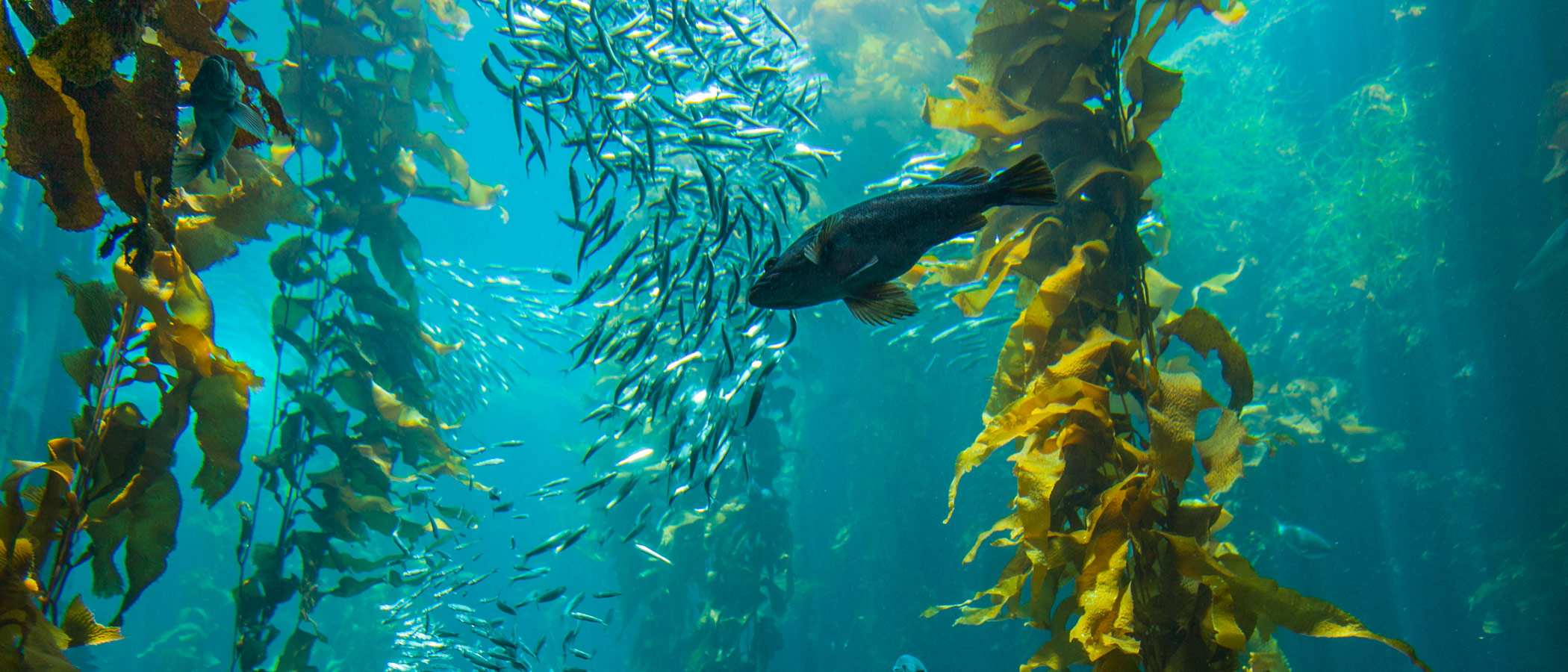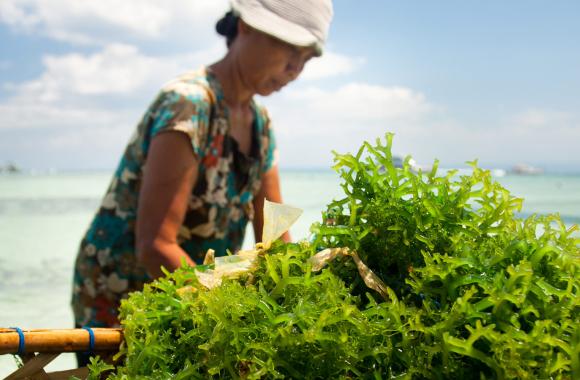Macroalgae Protection and Restoration
Macroalgae forests are among the most productive ecosystems on Earth. Protecting and restoring these habitats could enhance carbon sequestration in the deep sea.
Reduced/Sequestered
2020–2050
Impact
Protecting 160–199 million hectares of macroalgae forests globally by 2050 could sequester 1.84–2.28 gigatons of carbon dioxide. Even with successful protection, some regions will experience degradation, so restoration is key to increase climate impact. Restoring 14–26 million hectares of macroalgae forests would enhance sequestration of 0.77–1.50 gigatons of carbon dioxide. Financials are not projected because they are not incurred at the landholder level.
Introduction
Macroalgae are fast-growing marine plants. They store high amounts of carbon and are among the most productive organisms on Earth. Some of this exported carbon is sequestered in deep sea sediments. Although the ability of macroalgae to store substantial amounts of carbon for long periods of time remains in question, some have quantified the long- term carbon sequestration potential of macroalgae at 0.17 gigatons of carbon dioxide equivalent per year, exceeding the carbon buried in coastal angiosperm environments, such as mangroves, salt marshes, and seagrass beds (0.11–0.13 gigatons of carbon dioxide equivalent per year).
Macroalgae forests are broadly distributed throughout the global ocean, especially in temperate subtidal ecosystems. They provide habitat for fish and invertebrates. Globally, the area covered by macroalgae is decreasing 1.8 percent annually due to a combination of factors related to anthropogenic activity and climate warming. Marine Protected Areas (MPAs) and management actions such as protecting predators, minimizing harvest, and reducing eutrophication due to runoff can improve macroalgae forests’ resistance and resilience to climate change. Active restoration programs are also known to be successful, and more restoration sites are emerging worldwide.
Project Drawdown defines the Macroalgae Protection and Restoration solution as the legal protection of wild macroalgae forest ecosystems and processes or programs designed to return degraded wild macroalgae forest ecosystems to a healthy state. We assume the solution will be deployed in ocean areas that do not have alternative uses, including the protection of intact ecosystems.
Methodology
Total Ocean Area
The total ocean area considered for macroalgae protection is the global macroalgae cover excluding the natural annual rate of degradation for macroalgae and wild macroalgae harvest estimated until 2060. Thus, the total ocean area represents the total nondegraded macroalgae area available for protection between 2014 and 2060. Out of a total 355 million hectares available for macroalgae protection, we assume current (2018) adoption to be 0 due to a lack of data.
For macroalgae restoration, the total area available is the current total degraded macroalgae area. We set current adoption to 0 and increase it to 198 million hectares by 2050.
Adoption Scenarios
We based macroalgae protection on four adoption scenarios we developed using a variety of assumptions regarding total percentage of ocean area in MPAs by 2050 and annual growth rate of MPAs. We based macroalgae restoration on five adoption scenarios representing a more conservative approach and used a single example of a macroalgae restoration project in Korea (the most successful restoration project at this writing) as the more ambitious approach.
We calculated impacts of increased adoption of the Macroalgae Protection and Restoration solution from 2020 to 2050 by comparing two scenarios with a reference scenario in which the market share was fixed at current levels.
-
Scenario 1: 160 million hectares of unprotected macroalgae are protected and 14 million hectares of degraded macroalgae (52 percent of the total ocean considered) are restored.
-
Scenario 2: 199 million hectares of unprotected macroalgae are protected and 26 million hectares of degraded macroalgae (69 percent of the total ocean considered) are restored.
Sequestration and Carbon Storage
To calculate macroalgae’s sequestration rate, we multiplied net primary production of wild macroalgae by an estimated percent of carbon exported to the deep sea (which is considered long-term carbon sequestration). We arrived at a sequestration rate of 0.97 metric tons of carbon per hectare per year, with the net primary production estimate based on 13 data points from six sources and the percent of long-term carbon sequestration based on one source.
We estimated carbon storage in protected landscapes at 4.6 metric tons of carbon per hectare based on 13 data points from six sources.
Financial Model
We did not model financials because costs are not necessarily borne by the landowner or land manager.
Integration
This solution was not affected by integration with other solutions because we assume it will be developed in ocean areas that do not have alternative uses.
Results
Scenario 1 protects 1.22 gigatons of carbon dioxide equivalent. Scenario 2 scenario protects 3.78 gigatons of carbon dioxide equivalent.
Discussion
It is difficult to quantify how much carbon would be sequestered by the Macroalgae Protection and Restoration solution under various scenarios due to uncertainty in the extent to which the remains of dead plants find their way into deep-sea sediments. We found no study that estimated the potential carbon benefits of protecting macroalgae forests. Krause-Jensen and Duarte (2016) estimated sequestration of 0.64 gigatons of carbon dioxide equivalent. Our solution shows a maximum annual reduction of 0.15–0.33 gigatons in 2050. Adjusting for the proportion of the total carbon sequestration potential that might be attributed to macroalgae forest protection based on our two adoption scenarios (about 25–50 percent), our values and those of Krause-Jensen and Duarte (2016) are in line.
Many of the anthropogenic drivers of macroalgae destruction, such as eutrophication, harvesting, and fishing, can be addressed by local resources managers and may be ameliorated in part by protecting macroalgae forests in MPAs. However, even with the best efforts, some decline due to climate change is likely inevitable. This underscores the importance of also restoring habitat.
References
Krause-Jensen, D., & Duarte, C. M. (2016). Substantial role of macroalgae in marine carbon sequestration. Nature Geoscience, 9(10), 737–742. https://doi.org/10.1038/ngeo2790
What You Can Do
Learn about the importance of ocean ecosystems to human well-being and share what you learn with a friend.
Encourage your national government to support the development and protection of marine protected areas.
- Expand your knowledge by exploring another Drawdown solution.
Co-benefits
Macroalgae provide shelter and habitat for fishes and invertebrates and so contribute to food supplies for marine species such as sea otters, birds, and whales.



